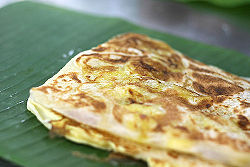
Back روتى كاناى ARZ চানাই রুটি Bengali/Bangla Roti prata Catalan Roti Canai German Roti canai Spanish روتی چانای Persian Roti canai French रोटी चनाई Hindi Roti canai ID ロティチャナイ Japanese
 Roti telur, a type of roti canai with egg filling, served on a banana leaf | |
| Alternative names |
|
|---|---|
| Type | Flatbread |
| Course | Main course, usually for breakfast |
| Region or state | Southeast Asia |
| Associated cuisine | Brunei, Indonesia, Malaysia, Singapore, and Thailand[1][2][3][4][5][6][7] |
| Created by | South Indian diaspora in Southeast Asia |
| Serving temperature | Hot |
| Main ingredients | Flour |
| Variations | Roti tissue, murtabak |
Roti canai, or roti prata, also known as roti chanai and roti cane, is an Indian flatbread dish found in several countries in Southeast Asia, especially Brunei, Indonesia, Malaysia, Singapore, and Thailand.[8] It is usually served with dal or other types of curry but can also be cooked in a range of sweet or savoury variations made with different ingredients, such as meat, eggs, or cheese.
In Southeast Asia, roti canai can often be found in cities that have populations of Indian descent, such as in West Sumatra, North Sumatra, and Aceh in Indonesia, as well as in Malaysia and Singapore.[9] Since being introduced around the 19th century, roti canai has become a popular breakfast and snack dish and is one of the most common examples of South Indian cuisine in the region.[1][10] It is said that the dish was brought by Indians during the era of British Malaya, the Dutch East Indies, and the Straits Settlements. It is served in street mamak stalls located in both rural and urban areas.[11][12][13]
It has also been theorized that the dish had been introduced much earlier, in the 17th century, in Aceh and North Sumatra, by Indian traders under the name roti cane.[14][15][9][16][17] In Indonesia, the dish is particularly found in Sumatra, where the Indian Indonesian community is more prominent compared to the rest of the country.[17]
- ^ a b "Roti Prata". Singapore Tourism Board.
- ^ Yi Jun Loh (22 May 2019). "The Indian Roti That Became Malaysia's National Bread". Taste. New York: Penguin Random House LLC.
- ^ Yip, Lynnett (29 February 2020). "What is roti canai, and why can't people in Southeast Asia get enough of it?". South China Morning Post. Hong Kong.
- ^ "Roti Canai (Mamak Copycat)". NyonyaCooking. 23 July 2016.
- ^ Krich, John (31 July 2009). "Roti Canai Kuala Lumpur takes a flatbread to new heights". The Wall Street Journal. New York: Dow Jones & Company.
- ^ "Roti Maryam/Konde/Cane/Canai". Indonesia Eats. 27 February 2008.
- ^ "Mencoba Roti Canai Asli Aceh di Tepi Jalan Pasar Minggu". Liputan6. 18 December 2016.
- ^ Cite error: The named reference
oedwas invoked but never defined (see the help page). - ^ a b Novita, Cicik (25 February 2022). "Resep Roti Canai dan Cara Membuatnya yang Dapat Dicoba di Rumah". tirto.id (in Indonesian). Retrieved 6 March 2024.
- ^ Krich, John (31 July 2009). "Roti Canai". Wall Street Journal. New York: Dow Jones & Company. ISSN 0099-9660. Retrieved 16 April 2018.
- ^ "Singapore hawker dishes: Roti prata". travelfish.org. TravelFish. Retrieved 13 January 2022.
- ^ "Malaysia's 5 mamak stall favoritesaccess-date=16 April 2018".
- ^ Staff writers. "The 10 types of roti you'll find at the mamak". Time Out Kuala Lumpur. Kuala Lumpur: Time Out International Limited. Retrieved 16 April 2018.
- ^ "Mengenal Asal Usul Roti Canai Yang Populer Di Wilayah Asia Tenggara". Timurasa.com (in Indonesian). 21 November 2020. Retrieved 21 March 2024.
- ^ Rinaldi, M Yon (17 November 2020). "Martabak Faliel Hadirkan Menu Khas Melayu Berkultur India, Ada Roti Cane Berbagai Topping". Tribun Jambi (in Indonesian). Retrieved 21 March 2024.
- ^ Adriansyah, Taufiq Dali (30 July 2023). "Resep Membuat Roti Canai, Makanan Khas Aceh yang Paling Cocok Temani Sarapan Pagi". Harian Haluan (in Indonesian). Retrieved 6 March 2023.
- ^ a b Cite error: The named reference
Kompaswas invoked but never defined (see the help page).